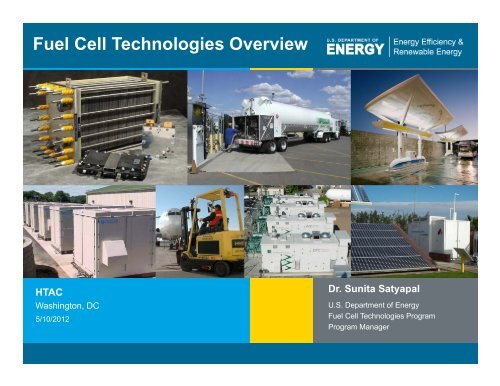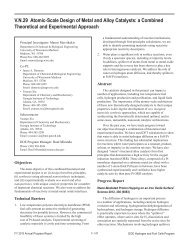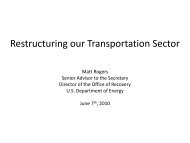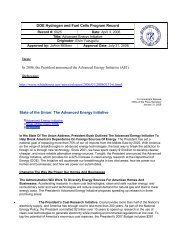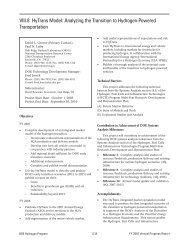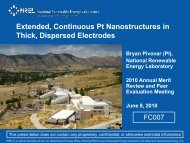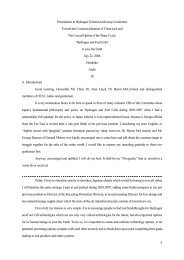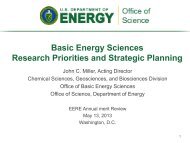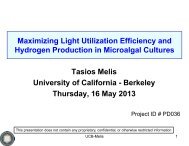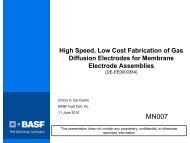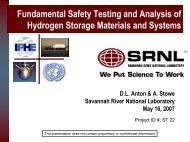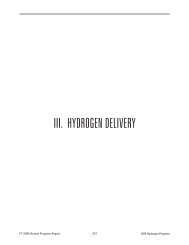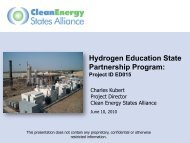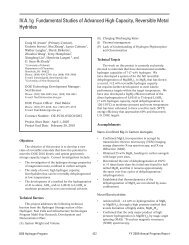Fuel Cell Technologies Overview - DOE Hydrogen and Fuel Cells ...
Fuel Cell Technologies Overview - DOE Hydrogen and Fuel Cells ...
Fuel Cell Technologies Overview - DOE Hydrogen and Fuel Cells ...
You also want an ePaper? Increase the reach of your titles
YUMPU automatically turns print PDFs into web optimized ePapers that Google loves.
<strong>Fuel</strong> <strong>Cell</strong> <strong>Technologies</strong> <strong>Overview</strong><br />
HTAC<br />
Washington, DC<br />
5/10/2012<br />
Dr. Sunita Satyapal<br />
U.S. Department of Energy<br />
<strong>Fuel</strong> <strong>Cell</strong> <strong>Technologies</strong> Program<br />
Program Manager<br />
1 | <strong>Fuel</strong> <strong>Cell</strong> <strong>Technologies</strong> Program Source: US <strong>DOE</strong> 5/11/2012 eere.energy.gov
Agenda<br />
• <strong>Fuel</strong> <strong>Cell</strong> Industry <strong>Overview</strong><br />
– Clean Energy Patents<br />
– Global OEM Update<br />
• Update on Progress<br />
– RD&D<br />
– Recovery Act<br />
• Budget Update<br />
– Funding Announcements<br />
• Additional Information<br />
2 | <strong>Fuel</strong> <strong>Cell</strong> <strong>Technologies</strong> Program Source: US <strong>DOE</strong> 5/11/2012 eere.energy.gov
<strong>Overview</strong><br />
<strong>Fuel</strong> <strong>Cell</strong>s – An Emerging Industry<br />
<strong>Fuel</strong> <strong>Cell</strong> Patents Geographic<br />
Distribution 2002-2011<br />
Japan<br />
31%<br />
Other<br />
3%<br />
United<br />
States<br />
46%<br />
Clean Energy Patent Growth Index<br />
Top 10 companies: GM, Honda, Samsung, Toyota,<br />
UTC Power, Nissan, Ballard, Plug Power, Panasonic,<br />
Delphi <strong>Technologies</strong><br />
Great<br />
Britain<br />
1%<br />
France<br />
1%<br />
Taiwan<br />
1%<br />
Canada<br />
3%<br />
Korea<br />
7%<br />
Germany<br />
7%<br />
Clean Energy Patent Growth Index [1] shows that fuel cell patents lead in the clean<br />
energy field with over 950 fuel cell patents issued in 2011.<br />
• Nearly double the second place holder, solar, which has ~540 patents.<br />
[1] http://cepgi.typepad.com/files/cepgi-4th-quarter-2011-1.pdf<br />
3 | <strong>Fuel</strong> <strong>Cell</strong> <strong>Technologies</strong> Program Source: US <strong>DOE</strong> 5/11/2012 eere.energy.gov
Worldwide Commitment to FCEVs<br />
The world’s leading automakers have committed to develop FCEVs. Germany <strong>and</strong><br />
Japan have announced plans to exp<strong>and</strong> the hydrogen infrastructure.<br />
Major Auto Manufacturers’ Activities <strong>and</strong><br />
Plans for FCEVs<br />
Toyota<br />
Honda<br />
• 2010-2013: U.S. demo fleet of 100 vehicles<br />
• 2015: Target for large-scale commercialization<br />
• “FCHV-adv” can achieve 431-mile range <strong>and</strong> 68 mpgge<br />
• Clarity FCX named “World Green Car of the Year”; EPA<br />
certified 72mpgge; leasing up to 200 vehicles<br />
• 2015: Target for large-scale commercialization<br />
Daimler • Small-series production of FCEVs began in 2009<br />
• Plans for tens of thous<strong>and</strong>s of FCEVs per year in 2015 –<br />
2017 <strong>and</strong> hundreds of thous<strong>and</strong>s a few years after<br />
• In partnership with Linde to develop fueling stations.<br />
• Recently moved up commercialization plans to 2014<br />
General<br />
Motors<br />
Hyundai-<br />
Kia<br />
• 115 vehicles in demonstration fleet<br />
• 2012: Technology readiness goal for FC powertrain<br />
• 2015: Target for commercialization<br />
• 2012-2013: 2000 FCEVs/year<br />
• 2015: 10,000 FCEVs/year<br />
• “Borrego” FCEV has achieved >340-mile range.<br />
Volkswagen • Exp<strong>and</strong>ed demo fleet to 24 FCEVs in CA<br />
• Recently reconfirmed commitment to FCEVs<br />
SAIC (China) • Partnering with GM to build 10 fuel cell vehicles in 2010<br />
Ford<br />
• Alan Mulally, CEO, sees 2015 as the date that fuel cell<br />
cars will go on sale.<br />
H 2 Mobility - evaluate the commercialization of H 2<br />
infrastructure <strong>and</strong> FCEVs<br />
• Public-private partnership between NOW <strong>and</strong><br />
9 industry stakeholders including:<br />
• Daimler, Linde, OMV, Shell, Total,<br />
Vattenfall, EnBW, Air Liquide, Air Products<br />
• FCEV commercialization by 2015.<br />
UKH 2 Mobility will evaluate anticipated FCEV<br />
roll-out in 2014/2015<br />
• 13 industry partners including:<br />
• Air Liquide, Air Products, Daimler,<br />
Hyundai, ITM Power , Johnson Matthew,<br />
Nissan, Scottish & Southern Energy, Tata<br />
Motors, The BOC Group, Toyota,<br />
Vauxhall Motors<br />
• 3 UK government departments<br />
• Government investment of £400 million to<br />
support development, demonstration, <strong>and</strong><br />
deployment.<br />
13 companies <strong>and</strong> Ministry of Transport<br />
announce plan to commercialize FCEVs by 2015<br />
BMW<br />
• 100 refueling stations in 4 metropolitan areas<br />
• BMW <strong>and</strong> GM plan to collaborate on the development<br />
of fuel cell technology<br />
<strong>and</strong> connecting highways planned, 1,000<br />
Based on publicly available information during 2011<br />
station in 2020, <strong>and</strong> 5,000 stations in 2030.<br />
4 | <strong>Fuel</strong> <strong>Cell</strong> <strong>Technologies</strong> Program Source: US <strong>DOE</strong> 5/11/2012 eere.energy.gov
<strong>DOE</strong> Program Structure<br />
The Program is an integrated effort, structured to address all the key challenges <br />
<strong>and</strong> obstacles facing widespread commercialization.<br />
Nearly 300 projects currently funded<br />
at companies, national labs, <strong>and</strong> universities/institutes<br />
More than $1B <strong>DOE</strong> funds spent from FY 2007 to FY 2011<br />
5 | <strong>Fuel</strong> <strong>Cell</strong> <strong>Technologies</strong> Program Source: US <strong>DOE</strong> 5/11/2012 eere.energy.gov
Federal Role in <strong>Fuel</strong> <strong>Cell</strong>s:<br />
RD&D to Deployments<br />
<strong>DOE</strong> R&D<br />
• Reduces cost <strong>and</strong> improves<br />
performance<br />
Examples:<br />
$300<br />
$250<br />
$200<br />
$150<br />
$100<br />
$50<br />
Transportation <strong>Fuel</strong> <strong>Cell</strong> System Cost<br />
- projected to high-volume (500,000 units per year) -<br />
Status:<br />
$49/kW<br />
(high vol)<br />
Target:<br />
$30/kW<br />
<strong>DOE</strong> Demonstrations<br />
& Technology Validation<br />
• Validate advanced<br />
technologies under realworld<br />
conditions<br />
• Feedback guides R&D<br />
Deployments<br />
• Market Transformation<br />
• <strong>DOE</strong> Recovery Act<br />
Projects<br />
• Government Early<br />
Adoption (DoD, FAA,<br />
California, etc.)<br />
• IDIQ*<br />
• Tax Credits: 1603, 48C<br />
Recovery Act & Market<br />
Transformation Deployments<br />
$0<br />
2002 2006 2007 2008 2009 2010 2011 2017<br />
Reduced cost of fuel cells 30%<br />
since 2008, 80% since 2001<br />
Reduced cost of electrolyzer<br />
stacks 60% since 2007<br />
Examples—validated:<br />
• 59% efficiency<br />
• 254 mile range<br />
(independently validated<br />
430-mile range)<br />
• 75,000-mi durability<br />
Program also includes enabling activities<br />
such as codes & st<strong>and</strong>ards, analysis, <strong>and</strong><br />
education.<br />
‣ 1,000 fuel cell deployments<br />
in ~ 2 years<br />
‣ 1 million hours of operation<br />
*IDIQ = indefinite delivery/indefinite quality<br />
6 | <strong>Fuel</strong> <strong>Cell</strong> <strong>Technologies</strong> Program Source: US <strong>DOE</strong> 5/11/2012 eere.energy.gov
Assessing the Impact of <strong>DOE</strong> Funding<br />
<strong>DOE</strong> funding has led led to 313 patents, ~33 commercial technologies <strong>and</strong> >60 emerging technologies.<br />
<strong>DOE</strong>’s Impact: ~$70M in funding for specific projects was tracked – <strong>and</strong> found to have led to nearly $200M<br />
in industry investment <strong>and</strong> revenues.<br />
35<br />
3M<br />
Examples<br />
Number of patents Cumulative Number of Commercial<br />
<strong>Technologies</strong><br />
30<br />
25<br />
20<br />
15<br />
10<br />
5<br />
0<br />
Pre<br />
2000<br />
2000 2001 2002 2003 2004 2005 2006 2007 2008 2009 2010 2011 2012*<br />
Source: Pacific Northwest National Laboratory<br />
http://www1.eere.energy.gov/hydrogen<strong>and</strong>fuelcells/pdfs/pathways_success_hfcit.pdf<br />
*Partial data for 2012<br />
>310 PATENTS resulting<br />
from EERE-funded R&D:<br />
- Includes technologies for<br />
hydrogen production <strong>and</strong><br />
delivery, hydrogen storage, <strong>and</strong><br />
fuel cells<br />
http://www1.eere.energy.gov/hydrogen<strong>and</strong>fuelcells/pdfs/path<br />
ways_2011.pdf<br />
Proton Energy<br />
Systems<br />
Quantum<br />
<strong>Technologies</strong><br />
BASF<br />
Catalysts LLC<br />
DuPont<br />
Dynalene,<br />
Inc.<br />
7 | <strong>Fuel</strong> <strong>Cell</strong> <strong>Technologies</strong> Program Source: US <strong>DOE</strong> 5/11/2012 eere.energy.gov
Program Mission<br />
The mission of the <strong>Hydrogen</strong> <strong>and</strong> <strong>Fuel</strong> <strong>Cell</strong>s Program is to<br />
enable the widespread commercialization of hydrogen <strong>and</strong> fuel<br />
cell technologies through:<br />
• basic <strong>and</strong> applied research<br />
• technology development <strong>and</strong> demonstration<br />
• Addressing institutional <strong>and</strong> market challenges<br />
Key Goals: Develop hydrogen <strong>and</strong> fuel<br />
cell technologies for:<br />
1. Early markets (e.g., stationary power, <br />
forklifts, portable power)<br />
2. Mid-term markets (e.g., residential CHP, <br />
auxiliary power, buses <strong>and</strong> fleet vehicles )<br />
3. Longer-term markets, 2015-2020 An integrated strategic plan for the research,<br />
(including mainstream transportation, with focus<br />
on passenger cars)<br />
development, <strong>and</strong> demonstration activities of <strong>DOE</strong>’s<br />
<strong>Hydrogen</strong> <strong>and</strong> <strong>Fuel</strong> <strong>Cell</strong>s Program<br />
http://hydrogen.energy.gov/roadmaps_vision.html<br />
8 | <strong>Fuel</strong> <strong>Cell</strong> <strong>Technologies</strong> Program Source: US <strong>DOE</strong> 5/11/2012 eere.energy.gov
Key Challenges<br />
The Program addresses the key challenges facing the widespread<br />
commercialization of fuel cells.<br />
Technology<br />
Barriers<br />
Economic &<br />
Institutional<br />
Barriers<br />
<strong>Fuel</strong> <strong>Cell</strong> Cost & Durability<br />
Targets:<br />
Stationary Systems: $1,000 to $1,500 per kW,<br />
60,000-80,000 hr durability<br />
Vehicles: $30 per kW, 5,000-hr durability<br />
<strong>Hydrogen</strong> Cost<br />
Target: $2 – 4 /gge, (dispensed <strong>and</strong> untaxed)<br />
<strong>Hydrogen</strong> Storage Capacity<br />
Target: > 300-mile range for vehicles—without<br />
compromising interior space or performance<br />
Safety, Codes & St<strong>and</strong>ards Development<br />
Domestic Manufacturing & Supplier Base<br />
Public Awareness & Acceptance<br />
<strong>Hydrogen</strong> Supply & Delivery Infrastructure<br />
Technology<br />
Validation:<br />
<strong>Technologies</strong> must<br />
be demonstrated<br />
under real-world<br />
conditions.<br />
Market<br />
Transformation<br />
Assisting the<br />
growth of early<br />
markets will help to<br />
overcome many<br />
barriers, including<br />
achieving<br />
significant cost<br />
reductions through<br />
economies of scale.<br />
9 | <strong>Fuel</strong> <strong>Cell</strong> <strong>Technologies</strong> Program Source: US <strong>DOE</strong> 5/11/2012 eere.energy.gov
Key Analysis Guides R&D Area<br />
Strategic technical analysis guides focus areas <strong>and</strong><br />
priorities for budget.<br />
Need to reduce high volume cost from $49/kW to $30/kW<br />
<strong>and</strong> increase durability from 2,500-hr to 5,000-hr.<br />
$60.00<br />
Key Focus<br />
Areas for<br />
R&D<br />
$50.00<br />
$49.00 $2.00<br />
$7.00<br />
$40.00<br />
$1.00<br />
$5.75<br />
$30.00<br />
$20.00<br />
$10.00<br />
$-<br />
13%<br />
16%<br />
37%<br />
23%<br />
12%<br />
Bipolar Plate<br />
Membrane<br />
Catalyst<br />
GDL<br />
MEA Frame <strong>and</strong> Gasket<br />
$1.25<br />
$2.00<br />
Bipolar Plates<br />
MEA<br />
Other Stack<br />
Compressor<br />
Humidifier<br />
Other BOP<br />
$30.00<br />
Sensitivity Analysis helps guide R&D<br />
Strategies to Address<br />
Challenges –<br />
Catalyst Examples<br />
●Lower PGM Content<br />
●Pt Alloys<br />
●Novel Support Structures<br />
●Non-PGM catalysts<br />
Targeted 80 kW PEM fuel cell system cost: $30/kW at 500,000 units/yr<br />
10 | <strong>Fuel</strong> <strong>Cell</strong> <strong>Technologies</strong> Program Source: US <strong>DOE</strong> 5/11/2012 eere.energy.gov
3<br />
H 2 Production & Delivery Cost Status<br />
The revised hydrogen threshold cost is a key driver in the assessment of<br />
<strong>Hydrogen</strong> Production <strong>and</strong> Delivery R&D priorities<br />
Projected High‐Volume Cost of <strong>Hydrogen</strong><br />
Production 1 (Delivered 2 )—Status<br />
Distributed Production (near term)<br />
Electrolysis<br />
Feedstock variability: $0.03 - $0.08 per kWh<br />
Bio-Derived Liquids<br />
Feedstock variability: $1.00 - $3.00 per gallon<br />
ethanol<br />
Natural Gas Reforming<br />
Feedstock variability: $4.00 - $10.00 per MMBtu<br />
Central Production (longer term)<br />
Electrolysis<br />
Feedstock variability: $0.03 - $0.08 per kWh<br />
Biomass Gasification<br />
Feedstock variability: $40- $120 per dry short ton<br />
Notes:<br />
[1] Cost ranges for each pathway are shown in 2007$ based on high-volume projections from H2A analyses,<br />
reflecting variability in major feedstock pricing <strong>and</strong> a bounded range for capital cost estimates.<br />
[2] Costs include total cost of production <strong>and</strong> delivery (dispensed, untaxed). Forecourt compression, storage <strong>and</strong><br />
dispensing added an additional $1.82 for distributed technologies, $2.61 was added as the price of delivery to<br />
central technologies. All delivery costs were based on the <strong>Hydrogen</strong> Pathways Technical Report (NREL, 2009).<br />
11 | <strong>Fuel</strong> <strong>Cell</strong> <strong>Technologies</strong> Program Source: US <strong>DOE</strong> 5/11/2012 eere.energy.gov
<strong>Hydrogen</strong> Production - Strategies<br />
Develop technologies to produce hydrogen from clean, domestic resources at a<br />
delivered <strong>and</strong> dispensed cost of $2-$4/gge H 2 by 2020<br />
12 | <strong>Fuel</strong> <strong>Cell</strong> <strong>Technologies</strong> Program Source: US <strong>DOE</strong> 5/11/2012 eere.energy.gov
Renewable Integration: Production<br />
from Wind<br />
Current <strong>DOE</strong> threshold costs can be met in some locations using electrolysis to<br />
produce hydrogen from wind<br />
Significance of Results<br />
• Wind incentives amounting to<br />
$0.02/kWh result in a $~1/kg H₂ cost<br />
reduction.<br />
•These incentives allow some sites to<br />
meet <strong>DOE</strong> targets.<br />
• Interactive tool allows users to<br />
provide input to the analysis <strong>and</strong> see<br />
updated results immediately.<br />
Users can:<br />
• Explore the effects of the four different<br />
balance scenarios; cost or power with &<br />
without the purchase of peak summer<br />
electricity.<br />
• Compare H₂ costs with <strong>DOE</strong> targets.<br />
• See the effects of wind power incentives on<br />
H₂ costs.<br />
• Add compression, storage, <strong>and</strong> dispensing<br />
costs.<br />
• See the effects of local topography.<br />
• See what’s at the site with Google Street<br />
View .<br />
http://www.nrel.gov/hydrogen/production_cost_analysis.html<br />
Does not<br />
meet cost<br />
target<br />
Meets<br />
cost<br />
target;<br />
Smaller<br />
is<br />
cheaper<br />
Street view showing<br />
wind turbines at a site.<br />
Mountains degrade the<br />
wind resource increasing<br />
H₂ costs by $1.5/kg.<br />
13 | <strong>Fuel</strong> <strong>Cell</strong> <strong>Technologies</strong> Program Source: US <strong>DOE</strong> 5/11/2012 eere.energy.gov
International Collaboration:<br />
Resource Analysis<br />
Objectives * :<br />
• Through collaboration with IEA<br />
analysts <strong>and</strong> IPHE, perform<br />
comprehensive technical <strong>and</strong><br />
market analysis of<br />
• <strong>Hydrogen</strong> technologies <strong>and</strong><br />
resources<br />
• Resource supply <strong>and</strong> dem<strong>and</strong><br />
related to projected hydrogen<br />
use<br />
• Global hydrogen infrastructure<br />
• GHG emissions <strong>and</strong> petroleum<br />
reduction<br />
• Identify international flows of:<br />
• Energy<br />
• <strong>Hydrogen</strong><br />
• Natural gas, LNG, coal<br />
• Platinum <strong>and</strong> other materials<br />
*<br />
Objectives for IEA <strong>Hydrogen</strong> Implementing Agreement Task 30<br />
International Resource Flow<br />
14 | <strong>Fuel</strong> <strong>Cell</strong> <strong>Technologies</strong> Program Source: US <strong>DOE</strong> 5/11/2012 eere.energy.gov
Recently Released States Reports<br />
Northeast <strong>Hydrogen</strong> <strong>Fuel</strong> <strong>Cell</strong> Industry Status <strong>and</strong> Direction<br />
Report by Joel M. Rinebold, <br />
Alex<strong>and</strong>er C. Barton, <strong>and</strong> Adam <br />
J. Brzozwski<br />
Connecticut Center for Advanced <br />
Technology, Inc.<br />
Highlights potential for fuel cell<br />
industry in northeast US detailing<br />
relevant information on products<br />
<strong>and</strong> markets, employment, <strong>and</strong><br />
system efficiency <strong>and</strong> cost.<br />
1.85 GW opportunity identified.<br />
See report:<br />
http://dl.dropbox.com/u/53527617/NORTHEAST%20HYDROGEN%20FUEL%<br />
20CELL%20INDUSTRY%20STATUS%20AND%20DIRECTION%202012.pdf<br />
Targets: Geographic Information System (GIS) Mapping<br />
Food Sales Food Services Inpatient Healthcare<br />
Education Airports (Military) Alternative <strong>Fuel</strong>ing Stations<br />
Lodging<br />
Energy Intensive Industry<br />
State by state plans identifying fuel cell opportunities <strong>and</strong> potential implementation<br />
strategies (drafts in process)<br />
15 | <strong>Fuel</strong> <strong>Cell</strong> <strong>Technologies</strong> Program Source: US <strong>DOE</strong> 5/11/2012 eere.energy.gov
Northeast <strong>Hydrogen</strong> <strong>Fuel</strong> <strong>Cell</strong> Cluster<br />
Preliminary Analysis- Economic Impact Summary<br />
CT NY MA ME NH RI VT NJ Regional<br />
Total<br />
Employment<br />
2,529 1,728 964 18 45 32 16 111 5,443<br />
Total Revenue<br />
/ Investment<br />
in 2010 ($<br />
million)<br />
$496 $292 $171 $2.9 $8.7 $6.9 $3.3 $26.5 $1,009<br />
Total Supply<br />
Chain<br />
Companies<br />
599 183 322 28 25 19 5 8 1189<br />
The Connecticut Center for Advance Technology, Inc.<br />
www.ccat.us<br />
16 | <strong>Fuel</strong> <strong>Cell</strong> <strong>Technologies</strong> Program Source: US <strong>DOE</strong> 5/11/2012 eere.energy.gov
Spark-Spread Determines Regional<br />
Opportunities for DG from Natural Gas<br />
2007 2010<br />
Source: NREL<br />
Spark spread determines regions for favorable<br />
use of natural gas<br />
Red/orange regions: High electricity cost, low<br />
natural gas cost- favorable for DG<br />
Lower natural gas prices offer increased opportunities for<br />
CHP <strong>and</strong> distributed generation- current vs. 2007<br />
17 | <strong>Fuel</strong> <strong>Cell</strong> <strong>Technologies</strong> Program Source: US <strong>DOE</strong> 5/11/2012 eere.energy.gov
Progress – Durability Assessment<br />
Aggregated results provide a benchmark in time of state-of-the-art fuel cell durability<br />
Hours<br />
NREL is aggregating <strong>and</strong> analyzing durability<br />
results by application that protect proprietary<br />
data, providing a benchmark in time of state-ofthe-art<br />
fuel cell durability. Results include 82 data<br />
sets from 10 fuel cell developers.<br />
45000<br />
40000<br />
35000<br />
30000<br />
25000<br />
20000<br />
15000<br />
10000<br />
5000<br />
25 th -75 th Percentile<br />
Max Op Hr<br />
Avg Op Hr<br />
Max Proj Hr 3<br />
Avg Proj Hr 3<br />
<strong>DOE</strong> Target 4<br />
49% of data sets<br />
are short stacks 2<br />
47% of data sets<br />
are short stacks 2<br />
20% of data sets<br />
are short stacks 2<br />
Application<br />
45% of data sets<br />
are short stacks 2<br />
Avg Projected Time to<br />
10% Voltage Drop<br />
Avg Operation<br />
Hours<br />
Backup power 2,400 1,100<br />
Automotive 4,000 2,700<br />
Forklift 14,600 4,400<br />
Prime 11,200 7,000<br />
PEM & SOFC data<br />
from lab tested, full<br />
active area short<br />
stacks <strong>and</strong> systems<br />
with full stacks.<br />
Data generated<br />
from constant load,<br />
transient load, <strong>and</strong><br />
accelerated testing.<br />
Please send inquires to<br />
<strong>Fuel</strong>celldatacenter@ee.doe.gov<br />
0<br />
Op Hr Proj Hr Op Hr Proj Hr Op Hr Proj Hr Op Hr Proj Hr<br />
Backup Automotive Forklift Prime<br />
J. Kurtz, et al., NREL<br />
18 | <strong>Fuel</strong> <strong>Cell</strong> <strong>Technologies</strong> Program Source: US <strong>DOE</strong> 5/11/2012 eere.energy.gov
FY 2012 Senate Mark Language <strong>and</strong><br />
Impact<br />
<strong>DOE</strong> FCT Program adjusted FY 2012 budget based on Senate Mark language.<br />
Excerpts from Senate Mark Language in the FY 2012 Appropriation<br />
“ The Committee recognizes the progress <strong>and</strong> achievements of the <strong>Fuel</strong> <strong>Cell</strong><br />
<strong>Technologies</strong> program. The program has met or exceeded all benchmarks, <strong>and</strong> has<br />
made significant progress in decreasing costs <strong>and</strong> increasing efficiency <strong>and</strong><br />
durability of fuel cell <strong>and</strong> hydrogen energy systems.”<br />
“ Within the available funds, the Committee recommends funding is provided for<br />
Technology Validation focused on passenger vehicle <strong>and</strong> hydrogen infrastructure<br />
applications, hydrogen fuels R&D, <strong>and</strong> for Market Transformation in early markets.”<br />
IMPACT<br />
FY 2012 Request: $100.5 M<br />
FY 2012 Appropriation: $104 M<br />
Following guidance from the Senate mark language:<br />
• $1 M was added to the original request for Technology Validation (total $9M)<br />
• $3 M was added for Market Transformation (total $3M)<br />
($33.8 M already planned for <strong>Hydrogen</strong> <strong>Fuel</strong>s R&D)<br />
19 | <strong>Fuel</strong> <strong>Cell</strong> <strong>Technologies</strong> Program Source: US <strong>DOE</strong> 5/11/2012 eere.energy.gov
EERE H 2 & <strong>Fuel</strong> <strong>Cell</strong>s Budgets<br />
Appropriations (FY 10 – FY 12) <strong>and</strong> Budget Request (FY 13)<br />
<strong>Hydrogen</strong> <strong>and</strong> <strong>Fuel</strong> <strong>Cell</strong> <strong>Technologies</strong><br />
Funding ($ in thous<strong>and</strong>s)<br />
Key Activity<br />
FY 2010<br />
Appropriation<br />
FY 2011<br />
Allocation<br />
FY 2012<br />
Appropriation<br />
FY 2013<br />
Request<br />
<strong>Fuel</strong> <strong>Cell</strong> Systems R&D 75,609 41,916 44,812 38,000<br />
<strong>Hydrogen</strong> <strong>Fuel</strong> R&D 45,750 32,122 34,812 27,000<br />
Technology Validation 13,005 8,988 9,000 5,000<br />
Market Transformation 15,005 0 3,000 0<br />
Safety, Codes &<br />
St<strong>and</strong>ards<br />
8,653 6,901 7,000 5,000<br />
Education 2,000 0 0 0<br />
FY 13<br />
House<br />
Mark<br />
$82 M<br />
FY 13<br />
Senate<br />
Mark<br />
$104 M<br />
Systems Analysis 5,408 3,000 3,000 3,000<br />
Manufacturing R&D 4,867 2,920 2,000 2,000<br />
Total $170,297 $95,847 $103,624 $80,000<br />
Notes: <strong>Hydrogen</strong> <strong>Fuel</strong> R&D includes <strong>Hydrogen</strong> Production & Delivery R&D <strong>and</strong> <strong>Hydrogen</strong> Storage R&D. FY11, FY12 include SBIR/STTR funds to be transferred to the Science<br />
Appropriation; prior years exclude this funding<br />
20 | <strong>Fuel</strong> <strong>Cell</strong> <strong>Technologies</strong> Program Source: US <strong>DOE</strong> 5/11/2012 eere.energy.gov
FY 2010 to FY 2013 Request <strong>and</strong><br />
Appropriation<br />
The <strong>Fuel</strong> <strong>Cell</strong> <strong>Technologies</strong> budget requests <strong>and</strong> appropriations summary<br />
<strong>Fuel</strong> <strong>Cell</strong> <strong>Technologies</strong> Budget ($ Million)<br />
Request Actual House Mark Senate Mark<br />
$174<br />
$137<br />
$98<br />
$100<br />
$104<br />
$104<br />
$68<br />
$80 $82<br />
FY 2010 FY 2011 FY 2012 FY 2013<br />
21 | <strong>Fuel</strong> <strong>Cell</strong> <strong>Technologies</strong> Program Source: US <strong>DOE</strong> 5/11/2012 eere.energy.gov
Funding Changes for New Awards<br />
The conference committee appropriation language changes how new R&D awards<br />
could be funded.<br />
Excerpts from Language<br />
“The conferees are concerned the Department is over-committing future budgets by announcing<br />
multi-year awards subject to future appropriations for a substantial portion of activities within Energy<br />
Programs.”<br />
“The Department is directed to transition to a model in which it fully funds multi-year awards with<br />
appropriated funds, except in the cases of major capital projects, management <strong>and</strong> operating<br />
contracts, <strong>and</strong> large research centers which require multi-year awards subject to appropriations.”<br />
POTENTIAL FUNDING CHANGES<br />
CURRENT SYSTEM<br />
Fund projects on a fiscal year basis<br />
Number of awards based on<br />
projected spending pattern<br />
Quantitative Go/No Go milestones<br />
PROPOSED SYSTEM<br />
Fully fund all projects up front<br />
Fewer awards made since all funds<br />
must be available in current year<br />
Quantitative Go/No Go milestones<br />
22 | <strong>Fuel</strong> <strong>Cell</strong> <strong>Technologies</strong> Program Source: US <strong>DOE</strong> 5/11/2012 eere.energy.gov
Methodology – Includes competitive review<br />
processes, peer reviews & risk analyses<br />
Topic Selection<br />
• Stakeholders<br />
• − e.g.: RF RFIs,<br />
HTAC<br />
• FreedomCAR industry, etc. &<br />
• <strong>Fuel</strong> U.S. DRIVE Partnership<br />
• Peer Reviews<br />
− • NAS NAS<br />
− • GAO<br />
− • Others<br />
• Targets<br />
• “Critical<br />
Path” needs<br />
• Technology<br />
Gaps<br />
• Risk Analysis<br />
• Technology<br />
Reviews<br />
RD&D Plan <strong>and</strong><br />
Solicitation<br />
Topics<br />
Example <strong>Fuel</strong> <strong>Cell</strong> Membrane Targets<br />
Project & Program Review Processes<br />
• Annual Merit Review & Peer Evaluation meetings (EE, NE, FE, SC)<br />
• FreedomCAR & <strong>Fuel</strong> Partnership Tech Team reviews (monthly)<br />
• Other peer reviews- National Academies, GAO, etc.<br />
• <strong>DOE</strong> quarterly reviews <strong>and</strong> progress reports<br />
Technical targets help guide go/no-go decisions.<br />
Project<br />
Number<br />
123<br />
Project Title<br />
PI Name &<br />
Organization<br />
Fluoroalkyl-Phosphonic-<br />
Acid-Based Proton<br />
Conductors<br />
Xxx University<br />
Discontinue<br />
Continue<br />
Final Score<br />
2.7 X<br />
Other<br />
Summary Comment<br />
Progress was made in molecular dynamics modeling<br />
of model compounds, but the membranes synthesized<br />
failed in testing <strong>and</strong> did not meet the conductivity<br />
targets. The project will not be continued.<br />
Over $19M<br />
saved in the last<br />
3 years through<br />
go/no-go<br />
decisions<br />
Reviewer comments for projects posted online annually. Projects discontinued/ work scope altered based on<br />
performance & likelihood of meeting goals.<br />
23 | <strong>Fuel</strong> <strong>Cell</strong> <strong>Technologies</strong> Program Source: US <strong>DOE</strong> 5/11/2012 eere.energy.gov
Subprogram Milestones <strong>and</strong> Targets -<br />
Examples<br />
Each subprogram has detailed<br />
milestones, inputs, outputs, gono<br />
go decision points <strong>and</strong><br />
technical targets<br />
Electrocatalysts<br />
for Transportation<br />
Applications<br />
Platinum group metal<br />
(PGM) total content<br />
(both electrodes)<br />
Example- Target Table for Electrocatalysts<br />
Status a<br />
Targets b<br />
2011 2017<br />
0.19 g/kW 0.125 g/kW<br />
PGM Total Loading 0.15 mg/cm 2 0.125 mg/cm 2<br />
Loss in catalytic (mass)<br />
activity c
Go / No-go Decisions & Independent<br />
Assessments<br />
“Go / No-go” decisions are used in downselecting certain research pathways to focus on the most<br />
promising areas. They are defined by performance-based technical milestones <strong>and</strong> quantitative<br />
metrics. Expert Panels are convened for independent assessments.<br />
A “no-go” decision<br />
• May indicate that further advances in basic science are needed<br />
• May eliminate an entire technology pathway<br />
Key examples<br />
• Single-walled Carbon Nanotubes — “no-go”<br />
• Thermochemical <strong>Hydrogen</strong> Production — three cycles selected out of 350<br />
• Sodium Borohydride for On-Board Vehicular <strong>Hydrogen</strong> Storage — “no-go”<br />
• On-board <strong>Fuel</strong> Processing — “no-go”<br />
The decision tree used by the<br />
Program in the process of downselecting<br />
pure carbon single-walled<br />
nanotubes (SWNTs) for hydrogen<br />
storage.<br />
As a result of the first no-go decision<br />
shown on the left side of the figure,<br />
funding was redirected to the areas<br />
shown on the right side of the figure.<br />
“Go/No-Go Decision: Pure, Undoped Single-Walled<br />
Carbon Nanotubes for Vehicular <strong>Hydrogen</strong> Storage,”<br />
U.S. Department of Energy, October 2006,<br />
www.hydrogen.energy.gov/pdfs/go_no_go_nanotubes.<br />
pdf.<br />
25 | <strong>Fuel</strong> <strong>Cell</strong> <strong>Technologies</strong> Program Source: US <strong>DOE</strong> 5/11/2012 eere.energy.gov
Funding Opportunity Announcements<br />
& Request for Information<br />
FY 2012 FOAs $M<br />
Collect Performance Data on <strong>Fuel</strong><br />
<strong>Cell</strong> Electric Vehicles<br />
$6.0<br />
<strong>Hydrogen</strong> <strong>Fuel</strong>ing Stations <strong>and</strong><br />
Innovations in <strong>Hydrogen</strong> $2.0<br />
Infrastructure <strong>Technologies</strong><br />
<strong>Fuel</strong> <strong>Cell</strong> Powered Baggage<br />
$2.5<br />
Vehicles at Commercial Airports<br />
Zero-Emission Cargo Transport<br />
$10.0<br />
Vehicles (VTP)<br />
Request for Information<br />
• <strong>Fuel</strong> <strong>Cell</strong> RFI on Preliminary Cost, Performance, <strong>and</strong><br />
Durability Targets for Class I, II, <strong>and</strong> III Lift Trucks.<br />
• Storage RFI on Early Market Targets<br />
• <strong>Hydrogen</strong> Production RFI on Potential Topics for H-Prize<br />
26 | <strong>Fuel</strong> <strong>Cell</strong> <strong>Technologies</strong> Program Source: US <strong>DOE</strong> 5/11/2012 eere.energy.gov
Examples of Key Activities: HTAC <strong>and</strong><br />
Program Impact<br />
• Annual Report<br />
• Input on Program Requests<br />
– Feedback on H 2 Threshold Cost<br />
–H 2 Enabling Renewables Working Group <br />
(subcommittee)<br />
–H 2 Production Expert Panel<br />
• Comprised of experts from industry, academia <strong>and</strong> the national labs<br />
• Goals:<br />
– Evaluate current status of hydrogen production technologies<br />
– Identify remaining challenges<br />
– Prioritize R&D needs<br />
– Strategize how to best leverage R&D among <strong>DOE</strong> Offices <strong>and</strong><br />
with other agencies<br />
Tasked with establishing paths forward for the widespread production of<br />
affordable renewable hydrogen for current markets <strong>and</strong> future energy scenarios<br />
27 | <strong>Fuel</strong> <strong>Cell</strong> <strong>Technologies</strong> Program Source: US <strong>DOE</strong> 5/11/2012 eere.energy.gov
Communication & Outreach<br />
Published more than 70 news articles in FY 2011<br />
(including blogs, progress alerts, <strong>and</strong> <strong>DOE</strong> FCT<br />
news alerts)<br />
Communication <strong>and</strong> Outreach Activities<br />
include:<br />
•Webinar Series<br />
• Continuing series of informational webinars led by FCT<br />
<strong>and</strong> partners on various topics.<br />
•News Items<br />
• Energy Department Awards More Than $7 Million for<br />
Innovative <strong>Hydrogen</strong> Storage <strong>Technologies</strong> in <strong>Fuel</strong><br />
<strong>Cell</strong> Electric Vehicles<br />
•Monthly Newsletter<br />
•Blogs<br />
"These technologies are part of a broad<br />
portfolio that will create new American<br />
jobs, reduce carbon pollution, <strong>and</strong><br />
increase our competitiveness in today's<br />
global clean energy economy."<br />
Progress in low <strong>and</strong><br />
zero Pt catalysts<br />
highlighted in<br />
Science<br />
<strong>Hydrogen</strong> power lights at<br />
the 2011 Golden Globes<br />
<strong>Hydrogen</strong> fuel cells providing<br />
critical backup power<br />
28 | <strong>Fuel</strong> <strong>Cell</strong> <strong>Technologies</strong> Program Source: US <strong>DOE</strong> 5/11/2012 eere.energy.gov
Key Reports<br />
The <strong>DOE</strong> <strong>Fuel</strong> <strong>Cell</strong> <strong>Technologies</strong> Program<br />
also funds the development <strong>and</strong> publication<br />
of key reports<br />
The Business Case for <strong>Fuel</strong> <strong>Cell</strong>s:<br />
Why Top Companies are Purchasing <strong>Fuel</strong> <strong>Cell</strong>s Today<br />
By <strong>Fuel</strong><strong>Cell</strong>s2000, http://www.fuelcells.org<br />
See report: http://www.fuelcells.org/BusinessCasefor<strong>Fuel</strong><strong>Cell</strong>s.pdf<br />
State of the States: <strong>Fuel</strong> <strong>Cell</strong>s in America<br />
By <strong>Fuel</strong><strong>Cell</strong>s2000, http://www.fuelcells.org<br />
See report: ttp://www.fuelcells.org/StateoftheStates2011.pdf<br />
2010 <strong>Fuel</strong> <strong>Cell</strong> Market Report<br />
By Breakthrough <strong>Technologies</strong> Institute, Inc. http://www.btionline.org/<br />
See report:<br />
http://www1.eere.energy.gov/hydrogen<strong>and</strong>fuelcells/pdfs/2010_market_report.pdf<br />
Annual Merit Review & Peer Evaluation Proceedings<br />
Includes downloadable versions of all presentations at the Annual Merit Review<br />
http://www.hydrogen.energy.gov/annual_review11_proceedings.html<br />
Annual Merit Review & Peer Evaluation Report<br />
Summarizes the comments of the Peer Review Panel at the Annual Merit Review <strong>and</strong><br />
Peer Evaluation Meeting<br />
http://hydrogen.energy.gov/annual_review11_report.html<br />
Annual Progress Report<br />
Summarizes activities <strong>and</strong> accomplishments within the Program over the preceding<br />
year, with reports on individual projects<br />
www.hydrogen.energy.gov/annual_progress.html<br />
Next Annual Review: May 14 – 18, 2012 Arlington, VA<br />
http://annualmeritreview.energy.gov/<br />
29 | <strong>Fuel</strong> <strong>Cell</strong> <strong>Technologies</strong> Program Source: US <strong>DOE</strong> 5/11/2012 eere.energy.gov
Partnerships & Collaboration<br />
•DOC<br />
•DOD<br />
•<strong>DOE</strong><br />
•DOT<br />
Federal Agencies<br />
• EPA<br />
•GSA<br />
•DOI<br />
• DHS<br />
− Interagency coordination through stafflevel<br />
Interagency Working Group (meets<br />
monthly)<br />
− Assistant Secretary-level Interagency<br />
Task Force m<strong>and</strong>ated by EPACT 2005.<br />
Universities<br />
~ 50 projects with 40 universities<br />
International<br />
•NASA<br />
•NSF<br />
•USDA<br />
•USPS<br />
• IEA Implementing agreements –<br />
25 countries<br />
• International Partnership for<br />
<strong>Hydrogen</strong> & <strong>Fuel</strong> <strong>Cell</strong>s in the<br />
Economy –<br />
17 countries & EC, 30 projects<br />
National Renewable Energy Laboratory<br />
P&D, S, FC, A, SC&S, TV, MN<br />
Argonne A, FC, P&D, SC&S<br />
Los Alamos S, FC, SC&S<br />
External Input<br />
• Annual Merit Review & Peer Evaluation<br />
• H2 & <strong>Fuel</strong> <strong>Cell</strong> Technical Advisory<br />
Committee<br />
• National Academies, GAO, etc.<br />
<strong>DOE</strong><br />
<strong>Hydrogen</strong> &<br />
<strong>Fuel</strong> <strong>Cell</strong>s<br />
Program<br />
National Laboratories<br />
S<strong>and</strong>ia P&D, S, SC&S<br />
Pacific Northwest P&D, S, FC, SC&S, A<br />
Oak Ridge P&D, S, FC, A, SC&S<br />
Lawrence Berkeley FC, A<br />
Industry Partnerships &<br />
Stakeholder Assn’s.<br />
• Tech Teams (USCAR, energy<br />
companies- U.S. DRIVE)<br />
• <strong>Fuel</strong> <strong>Cell</strong> <strong>and</strong> <strong>Hydrogen</strong> Energy<br />
Association (FCHEA)<br />
• <strong>Hydrogen</strong> Utility Group<br />
• ~ 65 projects with 50 companies<br />
State & Regional<br />
Partnerships<br />
• California <strong>Fuel</strong> <strong>Cell</strong> Partnership<br />
• California Stationary <strong>Fuel</strong> <strong>Cell</strong><br />
Collaborative<br />
• SC H 2 & <strong>Fuel</strong> <strong>Cell</strong> Alliance<br />
• Upper Midwest <strong>Hydrogen</strong> Initiative<br />
• Ohio <strong>Fuel</strong> Coalition<br />
• Connecticut Center for Advanced<br />
Technology<br />
Lawrence Livermore P&D, S, SC&S<br />
Savannah River S, P&D<br />
Brookhaven S, FC<br />
Idaho National Lab P&D<br />
Other Federal Labs: Jet Propulsion Lab, National Institute of St<strong>and</strong>ards &<br />
Technology, National Energy Technology Lab (NETL)<br />
P&D = Production & Delivery; S = Storage; FC = <strong>Fuel</strong> <strong>Cell</strong>s; A = Analysis; SC&S = Safety, Codes & St<strong>and</strong>ards; TV = Technology Validation, MN = Manufacturing<br />
30 | <strong>Fuel</strong> <strong>Cell</strong> <strong>Technologies</strong> Program Source: US <strong>DOE</strong> 5/11/2012 eere.energy.gov 30
World Class Researchers - Examples<br />
Adam Weber (LBNL) honored as Energy Technology<br />
Division Supramaniam Srinivasan Young Investigator<br />
Award from The Electrochemical Society in Seattle.<br />
Scott Samuelsen (UC Irvine) named a White House<br />
Champion of Change for his work as Director of the<br />
Advanced Power <strong>and</strong> Energy Program <strong>and</strong> the<br />
National <strong>Fuel</strong> <strong>Cell</strong> Research Center.<br />
Dr. Fern<strong>and</strong>o Garzon (LANL) was elected President<br />
of the National Electrochemical Society (ECS).<br />
3 Presidential Awardees:<br />
• Professor Susan Kauzlarich – UC Davis, a 2009 recipient of the Presidential<br />
Award for Excellence in Science, Mathematics <strong>and</strong> Engineering Mentoring—<br />
<strong>and</strong> a partner of the Chemical <strong>Hydrogen</strong> Storage Center of Excellence<br />
• Dr. Jason Graetz – Brookhaven National Laboratory, a 2009 recipient of the<br />
Presidential Early Career Award for Scientists <strong>and</strong> Engineers—<strong>and</strong> a partner<br />
of the Metal Hydride Center of Excellence<br />
• Dr. Craig Brown – NIST, a 2009 recipient of the Presidential Early Career<br />
Award for Scientists <strong>and</strong> Engineers—<strong>and</strong> a Partner of the <strong>Hydrogen</strong> Sorption<br />
Center of Excellence<br />
31 | <strong>Fuel</strong> <strong>Cell</strong> <strong>Technologies</strong> Program Source: US <strong>DOE</strong> 5/11/2012 eere.energy.gov
Additional Information<br />
32 | <strong>Fuel</strong> <strong>Cell</strong> <strong>Technologies</strong> Program Source: US <strong>DOE</strong> 5/11/2012 eere.energy.gov
Progress – <strong>Fuel</strong> <strong>Cell</strong>s<br />
Projected high-<br />
$300<br />
volume cost of fuel<br />
$250<br />
cells has been <br />
reduced to $49/kW $200<br />
(2011)*<br />
$150<br />
• More than 30% <br />
$100<br />
reduction since $50<br />
2008 $0<br />
• More than 80%<br />
reduction since<br />
2002<br />
*Based on projection to high-volume manufacturing (500,000 units/year).<br />
The projected cost status is based on an analysis of state-of-the-art<br />
components that have been developed <strong>and</strong> demonstrated through the <strong>DOE</strong><br />
Program at the laboratory scale. Additional efforts would be needed for<br />
integration of components into a complete automotive system that meets<br />
durability requirements in real-world conditions.<br />
System Cost ($/kW net )<br />
$275/kW<br />
0<br />
Projected Transportation <strong>Fuel</strong> <strong>Cell</strong> System Cost<br />
-projected to high-volume (500,000 units per year)<br />
Initial Estimate<br />
Balance of Plant ($/kW, <br />
includes assembly &<br />
testing)<br />
Stack ($/kW)<br />
$108/kW<br />
$94/kW<br />
$73/kW<br />
Current status:<br />
$49/kW vs<br />
target of $30/kW<br />
$61/kW $51/kW $49/kW<br />
Target<br />
$30/kW<br />
2002 2006 2007 2008 2009 2010 2011 2017<br />
Projected Costs at Different Manufacturing Rates<br />
$275<br />
$225<br />
$175<br />
$125<br />
$75<br />
$25<br />
$281<br />
$219<br />
$143<br />
$118<br />
$110 $94<br />
$82 $66<br />
$60<br />
2007 Cost<br />
2011 Status<br />
$49<br />
125,000 250,000 375,000 500,000<br />
Annual Production Rate (systems/year)<br />
33 | <strong>Fuel</strong> <strong>Cell</strong> <strong>Technologies</strong> Program Source: US <strong>DOE</strong> 5/11/2012 eere.energy.gov
Progress – Technology Validation<br />
Demonstrations are essential for validating technologies in integrated systems.<br />
Real-world Validation<br />
Vehicles & Infrastructure<br />
• >180 fuel cell vehicles <strong>and</strong> 25 hydrogen fueling<br />
stations<br />
• 3.6 million miles traveled<br />
• 152,000 kg of hydrogen produced or dispensed<br />
• 2,500 hours (nearly 75K miles) durability<br />
• 5 minute refueling time (4 kg of hydrogen)<br />
• Vehicle Range: ~196 – 254 miles (430 miles on<br />
separate FCEV)<br />
Buses (with DOT)<br />
• H 2 fuel cell buses have a 42% to 139% better fuel<br />
economy when compared to diesel & CNG buses<br />
Forklifts<br />
• Over 150,000 total refuelings since 2009<br />
CHHP (Combined Heat, <strong>Hydrogen</strong> <strong>and</strong> Power)<br />
• Demonstrated the world’s first facility for co-producing<br />
hydrogen <strong>and</strong> power (with 54% efficiency)<br />
Air Products, <strong>Fuel</strong> <strong>Cell</strong> Energy<br />
34 | <strong>Fuel</strong> <strong>Cell</strong> <strong>Technologies</strong> Program Source: US <strong>DOE</strong> 5/11/2012 eere.energy.gov
State of the States<br />
Additional States to Watch<br />
Hawaii - hydrogen station at Hickam Air Force Base,<br />
recently launched the Hawaii <strong>Hydrogen</strong> Initiative (H2I)<br />
with GM, starting a renewable hydrogen generation <strong>and</strong><br />
refueling station with the Navy<br />
Texas - <strong>Fuel</strong> cell forklift deployments by several major<br />
food distributors (e.g. HEB, Sysco)<br />
Delaware - non-renewable fuel cells added to net<br />
metering, two fuel cell buses. home to major fuel cell<br />
component suppliers<br />
Florida - Cleantech Industry Cluster includes fuel cells<br />
Maryl<strong>and</strong> - <strong>Fuel</strong>Works research center at University of<br />
Maryl<strong>and</strong>, Whole Foods forklift fleet among country’s<br />
largest<br />
The Business Case for <strong>Fuel</strong> <strong>Cell</strong>s:<br />
Why Top Companies are Purchasing <strong>Fuel</strong> <strong>Cell</strong>s Today<br />
By <strong>Fuel</strong><strong>Cell</strong>s2000, http://www.fuelcells.org<br />
34 companies profiled in the report, cumulatively, have ordered, installed or deployed:<br />
• more than 1,000 fuel cell forklifts;<br />
• >250 fuel cells totaling 30+ MWs of stationary power;<br />
• more than 240 fuel cell units at telecom sites.<br />
State of the States: <strong>Fuel</strong> <strong>Cell</strong>s in America<br />
By <strong>Fuel</strong><strong>Cell</strong>s2000, http://www.fuelcells.org<br />
Report analyzing the seven regions of the United States, compiling state activities<br />
supporting fuel cell <strong>and</strong> hydrogen policy, as well as installations <strong>and</strong> demonstrations<br />
in each state.<br />
See report: http://www.fuelcells.org/StateoftheStates2011.pdf<br />
Emerging Market<br />
Opportunities for States<br />
<strong>Hydrogen</strong> <strong>and</strong> fuel cell technologies can be<br />
utilized across a wide spectrum of industries for<br />
several different applications including:<br />
• Material H<strong>and</strong>ling Equipment<br />
• Backup power<br />
• Combined-heat-<strong>and</strong>-power<br />
Major companies including FedEx, Coca-Cola,<br />
AT&T, Wegmans, <strong>and</strong> Whole Foods (among<br />
others) are utilizing fuel cell technology today.<br />
35 | <strong>Fuel</strong> <strong>Cell</strong> <strong>Technologies</strong> Program Source: US <strong>DOE</strong> 5/11/2012 eere.energy.gov
<strong>Fuel</strong> <strong>Cell</strong>s at the Olympics<br />
UK H 2 Mobility plans fuel cell taxis at the 2012 London Olympics as a part of their<br />
greater goal to ensure the UK is positioned for the commercial roll-out of FCEVs<br />
London l<strong>and</strong>scape - largest urban zone in<br />
the EU with 23.8 million transport trips per<br />
average London day<br />
• Clean Air Zone already implemented; clean-up of London buses<br />
(particulate filters, new hybrids); age limit to taxis; focus on ultra low<br />
emission vehicles (free access to congestion charge zones)<br />
Intelligent Energy <strong>and</strong> HyTEC consortium is<br />
bringing the first zero emission taxi fleet to<br />
the streets of London for launch in time for<br />
the Olympics<br />
• Mayor Boris Johnson proponent – quoted in Leading to a Greener<br />
London: “London has an unrivalled opportunity to benefit from an emphatic<br />
shift to a low carbon economy. The time for trials <strong>and</strong> experiments is over.<br />
We are putting in place large scale programmes that can deliver significant<br />
CO2 reductions <strong>and</strong> billions of pounds in energy savings”<br />
• The Greater London Authority has set aims <strong>and</strong> objectives to<br />
promote clean transportation via adoption of the London <strong>Hydrogen</strong><br />
Action Plan :<br />
• Creating conditions for the deployment of hydrogen<br />
refuelling infrastructures<br />
• Considering all aspects of hydrogen supply <strong>and</strong> storage to<br />
ensure a future proof solution<br />
• Vehicle fleets (buses) being implemented in service<br />
5 taxis planned for use throughout Olympics<br />
36 | <strong>Fuel</strong> <strong>Cell</strong> <strong>Technologies</strong> Program Source: US <strong>DOE</strong> 5/11/2012 eere.energy.gov
Portable Power Targets<br />
Portable Power<br />
Applications, Under 2W 1<br />
Portable Power<br />
Applications, 10-50 W 1<br />
Portable Power<br />
Applications, 100-250 W 1<br />
Units 2011 Status 2015 Target 2011 Status 2015 Target 2011 Status 2015 Target<br />
Specific<br />
Power 2 W/kg<br />
5 10 15<br />
45 25 50<br />
Power Density 2 W/L 7 13 20 55 30 70<br />
Specific<br />
Energy 2,3 Wh/kg 110 230 150 650 250 640<br />
Energy<br />
Density 2,3 Wh/L 150 300 200 800 300 900<br />
Cost 4 $/system 150 70 15 7 15 5<br />
Durability 5,6 hours 1500 5000 1500 5000 2000 5000<br />
Mean Time<br />
Between<br />
hours 500 5000 500 5000 500 5000<br />
Failures 6,7<br />
Assumptions <strong>and</strong> supporting information can be found here: http://hydrogen.energy.gov/pdfs/11009_portable_fuel_cell_targets.pdf.<br />
37 | <strong>Fuel</strong> <strong>Cell</strong> <strong>Technologies</strong> Program Source: US <strong>DOE</strong> 5/11/2012 eere.energy.gov
APU Targets<br />
Revised FCT fuel cell APU targets published in 2010<br />
Characteristic 2011 Status 2013 Targets 2015 Targets 2020 Targets<br />
Electrical efficiency<br />
at rated power a 25% 30% 35% 40%<br />
Power density 17 W/L 30 W/L 35 W/L 40 W/L<br />
Specific power 20 W/kg 35 W/kg 40 W/kg 45 W/kg<br />
Factory cost, stack<br />
plus required BOP b $750/kW c $700/kW $600/kW $500/kW<br />
Factory cost,<br />
system d $2,000/kW $1,400/kW $1,200/kW $1,000/kW<br />
Transient response<br />
(10 to 90% rated<br />
power)<br />
5 min 4 min 3 min 2 min<br />
Start-up time from:<br />
20 °C<br />
St<strong>and</strong>by<br />
conditions e<br />
50 min<br />
50 min<br />
45 min<br />
20 min<br />
45 min<br />
10 min<br />
30 min<br />
5 min<br />
Degradation with<br />
cycling f 2.6%/1,000 h 2%/1,000 h 1.3%/1,000 h 1%/1,000 h<br />
Operating lifetime f, g 3,000 h 10,000 h 15,000 h 20,000 h<br />
System availability h 97% 97.5% 98% 99%<br />
Assumptions <strong>and</strong> supporting information can be found here:<br />
http://hydrogen.energy.gov/pdfs/11001_apu_targets.pdf<br />
APU targets were developed<br />
using:<br />
• Comparison with incumbent<br />
technology (diesel ICE APUs)<br />
• An RFI process to obtain<br />
input from stakeholders<br />
• Direct discussion with<br />
developers<br />
Example: 2020 power density<br />
target<br />
Stakeholder recommendations:<br />
20 – 55 W/L<br />
Incumbent technology: 11 – 33<br />
(mean 20) W/L<br />
Final <strong>DOE</strong> 2020 target: 40 W/L –<br />
within range suggested by<br />
stakeholders <strong>and</strong> superior to<br />
incumbent technology<br />
38 | <strong>Fuel</strong> <strong>Cell</strong> <strong>Technologies</strong> Program Source: US <strong>DOE</strong> 5/11/2012 eere.energy.gov
Micro-CHP Targets<br />
Targets developed with input from stakeholders <strong>and</strong> the research community<br />
Cost <strong>and</strong> durability are the major challenges<br />
Characteristic 2011 Status 2015 Targets 2020 Targets<br />
Electrical efficiency at rated power b 34-40% 42.5% >45% c<br />
CHP energy efficiency d 80-90% 87.5% 90%<br />
Equipment cost e , 2-kW avg<br />
f<br />
system NA $1,200/kW avg $1,000/kW avg<br />
Equipment cost e , 5-kW avg system $2,300 - $4,000/kW g $1,700/kW avg $1,500/kW avg<br />
Equipment cost e , 10-kW avg system NA $1,900/kW avg $1,700/kW avg<br />
Transient response (10 - 90% rated<br />
power)<br />
Start-up time from 20°C ambient<br />
temperature<br />
5 min 3 min 2 min<br />
EERE Budget Appropriations <strong>and</strong> Request<br />
Funding ($ in thous<strong>and</strong>s)<br />
EERE Program<br />
FY 2010<br />
Appropriation<br />
FY 2011<br />
Allocation<br />
FY 2012<br />
Appropriation<br />
FY 2013<br />
Request<br />
<strong>Hydrogen</strong> & <strong>Fuel</strong> <strong>Cell</strong> <strong>Technologies</strong> 170,297 95,847 103,624 80,000<br />
Biomass & Biorefinery Systems R&D 216,225 179,979 199,276 270,000<br />
Solar Energy 243,396 259,556 288951 310,000<br />
Wind Energy 79,011 78,834 93,254 95,000<br />
Geothermal <strong>Technologies</strong> 43,120 36,992 37,862 65,000<br />
Water Power 48,669 29,201 58,787 20,000<br />
Vehicle <strong>Technologies</strong> 304,223 293,151 328,807 420,000<br />
Building <strong>Technologies</strong> 219,046 207,310 219,204 310,000<br />
Advanced Manufacturing 94,270 105,899 115,580 290,000<br />
Federal Energy Management Program 32,000 30,402 29,891 32,000<br />
Facilities & Infrastructure 19,000 51,000 26,311 26,400<br />
Weatherization <strong>and</strong> Intergovernmental 270,000 231,300 128,000 195,000<br />
Program Direction 140,000 170,000 165,000 164,700<br />
Strategic Programs 45,000 32,000 25,000 58,900<br />
Adjustments 292,135 (29,750) (9,909) (69,667)<br />
Total $2,216,392 $1,771,721 $1,809,638 $2,267,333<br />
FY 13<br />
House<br />
Mark<br />
(HFCT)<br />
$82M<br />
FY 13<br />
Senate<br />
Mark<br />
(HFCT)<br />
$104 M<br />
40 | <strong>Fuel</strong> <strong>Cell</strong> <strong>Technologies</strong> Program Source: US <strong>DOE</strong> 5/11/2012 eere.energy.gov
<strong>DOE</strong> <strong>Hydrogen</strong> Budget<br />
EERE<br />
<strong>Hydrogen</strong> &<br />
<strong>Fuel</strong> <strong>Cell</strong>s<br />
Fossil Energy<br />
(FE)<br />
Nuclear<br />
Energy (NE)<br />
Funding ($ in thous<strong>and</strong>s)<br />
FY 2007 FY 2008 FY 2009 FY 2010 FY 2011 FY 2012 FY 2013<br />
Approp. Approp. Approp. Approp. Allocation Approp. Request<br />
189,511 206,241 195,865 170,297 95,847 101,087 77,850<br />
21,513 14,891 20,151 13,970 11,394 0 0<br />
18,855 9,668 7,340 5,000 2,800 0 0<br />
EERE FY 13<br />
House Mark:<br />
$82 M<br />
EERE FY 13<br />
Senate Mark:<br />
$104 M<br />
SECA House &<br />
Senate Mark:<br />
$25 M<br />
Science (SC) 36,388 36,483 38,284 38,053 34,611 ~34,611 TBD<br />
<strong>DOE</strong> TOTAL 266,267 267,283 261,640 227,320 144,652 ~135,698 TBD<br />
Notes<br />
Nuclear Energy: In 2010 <strong>and</strong> 2011, development of HTSE at the Idaho National Laboratory (INL) continued with funding from the<br />
NGNP project. Several industry partners now have stack technologies for high temperature steam electrolysis in development. After<br />
demonstration of pressurized HTSE stack operation in FY 2012 by INL, the technology readiness is expected to be sufficiently<br />
advanced (TRL5) to allow for further development by industry.<br />
EERE: FY 2012 appropriation <strong>and</strong> FY 2013 request exclude the estimated SBIR/STTR funding.<br />
41 | <strong>Fuel</strong> <strong>Cell</strong> <strong>Technologies</strong> Program Source: US <strong>DOE</strong> 5/11/2012 eere.energy.gov


